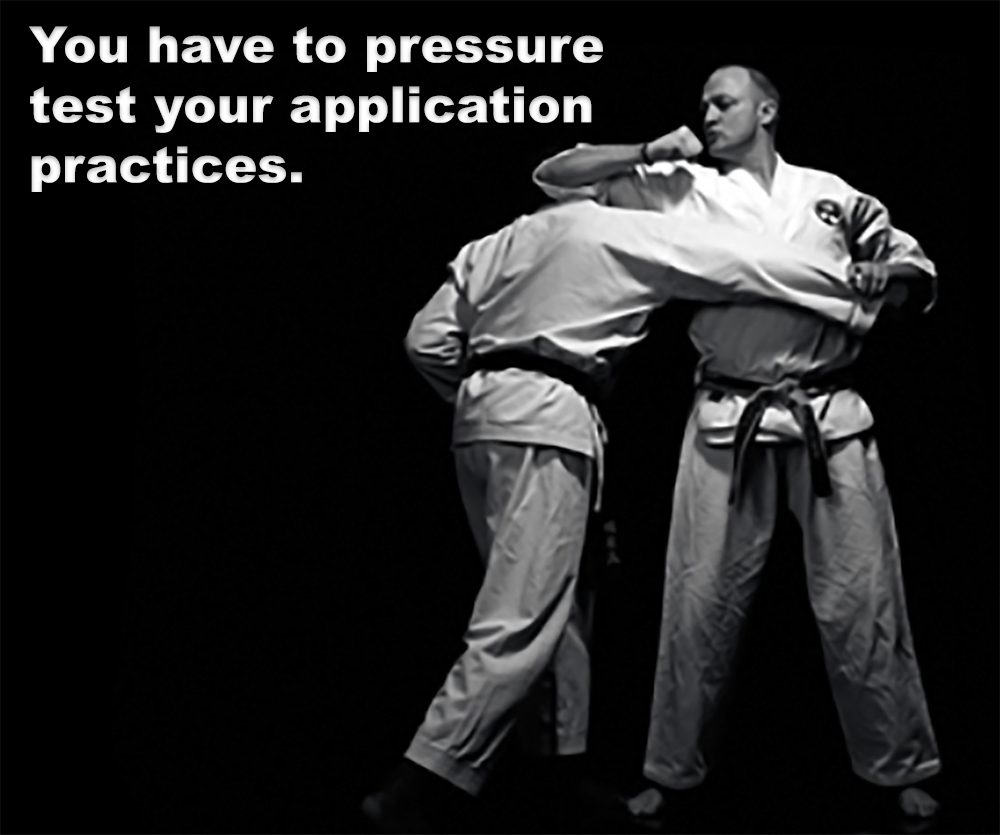
You have to pressure test your application practices.
Posted by ADAM CARTER on NOV 8, 2022

You have to pressure test your application practices.
Most practitioners today do not have to face real violence which is unscripted and random. Any application practice, which is pragmatic in nature, should include many variations in technique and movement, using varying levels of resistance.
There HAS to be resistance, with unpredictability and failure demonstrated and practiced. You have to show what would happen when the attacker is resisting, pulling, pushing, twisting, grabbing, moving to a different position.
Even if you are lucky enough, or skilled enough, to apply your technique, the attacker will respond to this, therefore you have to show his response. His limbs, head, torso all moving to a different position to when the confrontation started.
In a real physical self-defense situation, a situation that kata were created for, your opponent is going to both resist and be uncooperative, or do something completely unexpected. He will NOT allow you to do what you want with him.
Progressive resistance needs to be shown and practiced. You have to learn how to be compliant first, learn the technique before you start resisting and fighting each other. You work with your partner to find the amount of resistance needed in order to work on learning the fundamentals.
Some compliance in training is a good thing... it means that you are following recommended best practices and guidelines.
If someone in training is not trying to hit or perform a technique in a realistic manner, then they are non-compliant. The person giving a realistic attack is the one that is being compliant. As one progressively increases the resistance in training, that should be regarded as moving towards more intensity and freedom of movement. You start with very strict guidelines as to what is allowed (highly predictable) and progress to a more free form (unrestricted) training.
Being compliant is a good thing. What is bad is that if you never progress to free-form attacks, where unpredictability is the king.
In kata application training, if your partner deviates from the kata, you should not have to think about what you do next. It should be intuitive to strike or perform a movement when your partner has left an opening, and in doing so, prevent them from successfully attacking you further. Even within the restricted guidelines of kata, the mindset should be one of freedom of movement/action. This can take a long time to develop... at first, if someone deviates from a kata, a student might flinch and is likely to overthink what comes next instead of acting intuitively.
Resistance is something that has to be approached gradually. The problem with some students resisting, is that they don't know how to resist. Sometimes students will resist techniques very strongly, presuming that they are being realistic. In truth, they are anticipating the technique and trying to thwart it.
As practice increases, you should be encouraged to train at full resistance and try and make your techniques work effectively. These sessions can be very useful as it shows you exactly what level you have reached for a particular technique or movement. It shows you without a doubt, what you can make work, and what you can't.
You will be surprised at how many times you actually manage to make the technique effective. When tactics change, you should be able to adapt or change the technique to make it work.
Understand the mechanics of a technique, of a movement, and the situation in which it should be applied. Emphasize how important it is to have the basic, perfect technique ingrained into your head. Knowing how each technique should work as both an attacker and defender is essential when you start speeding things up and resisting.
An attacker isn’t going to remain in one place for you to apply your multi-faceted technique on him. It’s just fantasy. Demonstrating your exquisite “Bunkai” is all well and good when the attacker engages in a single, uncommitted attack. Integrate his response to yours and show resistance, non-compliance and sometimes failure….. learn to adapt.
![]() Photo Credit and with thanks to Gavin Mulholland Daigaku Karate Kai
Photo Credit and with thanks to Gavin Mulholland Daigaku Karate Kai
